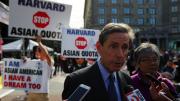In a packed Boston courtroom Monday, Harvard and the anti-affirmative-action group Students for Fair Admissions (SFFA) presented arguments in the first day of trial of a four-year-old civil-rights lawsuit charging that the College’s admissions office discriminates against Asian-American students. Top University administrators including former president Drew Faust, former dean of the Faculty of Arts and Sciences Mike Smith, College dean Rakesh Khurana, and director of admissions Marlyn McGrath will all testify in the case.
This summer, the U.S. Department of Justice withdrew Obama administration guidelines on the use of race in college admissions, and filed a statement of support for SFFA in the case. All the other schools in the Ivy League, plus nine other private universities, have filed a joint friend-of-the-court brief this summer defending the use of race in admissions. The trial is expected to run through November, and U.S. District Judge Allison Burroughs will likely rule several months later.
In his opening statement, Adam Mortara, an attorney for SFFA, told Judge Burroughs that Harvard’s practice of assigning applicants subjective “personal” ratings results in discrimination against Asian Americans. “The ‘personal’ rating is crucial to admission to Harvard,” Mortara said, citing “undisputed evidence” that “Asian-American applicants to Harvard receive substantially lower personal ratings than white applicants.” He argued that despite their importance to the admissions process, the “personal” scores are ill defined and invite implicit bias and racial discrimination. An exhibit presented by Mortara showed that the score is assessed on a four-point scale: “1.Outstanding 2.Very Strong 3.Generally positive 4.Bland or somewhat negative or immature.” Mortara also said that Asian-American applicants on average perform better than whites on other measures used by the admissions office—academic and extracurricular.
“The future of affirmative action in college admissions is not on trial here,” Mortara said. “The Supreme Court has held that race can be used in a narrowly tailored way to unlock the benefits of diversity in education.” Instead, he said, SFFA aimed to prove that white students were given an advantage over better-qualified Asian-American applicants. “Harvard is pushing down Asian Americans on this all-important, subjective ‘personality’ rating.”
Burroughs has already dismissed SFFA’s claim that race should not be a factor in college admissions, deferring to Supreme Court precedent on the issue; instead, she will consider whether Harvard’s admissions process discriminates against Asian Americans. Nevertheless, the legality of affirmative action may be considered by a higher court if the case is later appealed, as it almost certainly will be. Edward Blum, the founder and president of SFFA, may anticipate a favorable audience among the now majority-conservative Supreme Court, which he hopes will rule the use of race in admissions unconstitutional.
Blum, a well-known conservative political activist and opponent of affirmative action, sponsored Shelby County v. Holder, the Supreme Court case that invalidated Article V of the Voting Rights Act. He also led the much-followed 2016 case Fisher v. University of Texas, in which Abigail Fisher, a white woman who was denied admission to the school, alleged the institution discriminated against her on the basis of race. In that case, the Supreme Court upheld the University of Texas’s policies, ruling that college affirmative-action programs must be tailored narrowly and show that they accomplish a specific goal, and ruling also that colleges must prove that race-based admissions policies are the only way to meet diversity goals.
Mortara contended that University officials have long known about the “statistically significant penalty on Asian Americans applying to Harvard.” Reports by Harvard’s Office of Institutional Research in 2012 and 2013, which were included in court documents filed by SFFA this summer, found that Harvard’s admissions process had “negative effects” for Asian Americans. “Harvard and [William Fitzsimmons, dean of admissions and financial aid] did nothing that you would expect a reasonable employer or university or institution to do,” Mortara said. “Which is to deal with the problem…Dean Fitzsimmons did not tell anyone in his chain of command about it. He did not tell Drew Faust about these warning flags, and he did not tell the director of admissions, Marlyn McGrath, whom he had been working with for 30 years.”
Mortara argued that beginning with the admissions cycle for the class of 2019, coinciding with the time the lawsuit was filed, “the Asian penalty [went down] substantially”—Harvard began admitting a higher share of Asian-American students. “Why is that? That’s because when Harvard knew that someone was going to be looking into what’s going on, they dialed down the Asian penalty. This is powerful, circumstantial evidence of discrimination.” (Harvard’s lead lawyer later forcefully refuted this claim.)
Mortara also condemned the strong preferences given to children of Harvard graduates and faculty and staff members, donors, and recruited athletes, which also advantage white students relative to Asian Americans. “Harvard steadfastly refuses to even contemplate giving up legacy and donor preferences,” he said.
“Harvard doesn’t need to use race as a factor in admissions to enroll a significant number of Asians and whites,” Mortara said in closing. “The court might reasonably ask why Harvard needs to distinguish Asian Americans and whites at all in its process…Why didn’t Harvard blind itself to the difference between whites and Asians after its own researchers pointed out the existence of an Asian penalty?...Harvard has engaged in and continues to engage in intentional discrimination against Asian Americans.”
In an opening statement following Mortara’s, William F. Lee ’72, Harvard’s lead lawyer in the case and senior fellow of the Harvard Corporation, denied that the University discriminates against Asian Americans in admissions, stressing that SFFA’s aim is to end affirmative action. “To be clear,” he said, “the Plaintiff’s stated goal is to change the law and eliminate all consideration of race in college admissions.”
Lee also argued that SFFA’s claims of discrimination were unsupported, that Harvard’s admissions process has been upheld as exemplary by the Supreme Court (by using race only as a “plus” factor, and evaluating each applicant as an individual), and that diversity is central to the University’s educational mission. Applicants’ “personal” ratings, he said, were determined by information conveyed to admissions officers through sources like teacher and guidance-counselor recommendations.
After nearly four years of litigation, Lee said, and the release of data on more than 200,000 applicants to Harvard over a six-year period, SFFA can’t prove that Harvard discriminates against Asian-American applicants. He stressed that race is never the sole or determining factor in an applicant’s admissions decision: “Instead, the evidence will confirm that, as permitted by the Supreme Court, race is considered as one factor among many in the Harvard admissions process; that when it is considered, it is considered flexibly; and that it is always used as a ‘plus’ factor.” A candidate’s race is never considered a negative in admissions, he later said.
Harvard’s admissions process “was lauded by Supreme Court in Bakke as an ‘illuminating example,’” Lee said, citing Regents of the University of California v. Bakke, the 1978 case that upheld affirmative action, ruling that race may be used as one factor in college admissions, but not as part of a racial-quota system.
Lee also stressed the recent increase in the share of Asian-American students at the College: “From the class of 2006 to the class of 2019, the percent of Asian Americans in the admitted class increased from 16.5 percent to almost 21 percent—an increase of approximately 25 percent. This representation has continued to increase. Last year—for the class of 2022—Asian Americans were almost 23 percent of the admitted class. The idea that being sued by SFFA is the reason these numbers have gone up is simply not true.”
SFFA’s and Harvard’s arguments rely on conflicting testimony from two expert witnesses: for SFFA, Peter Arcidiacono, a Duke economist who analyzed Harvard’s admissions data and concluded that its process discriminates against Asian Americans through its use of a personality score for applicants; and for Harvard, David Card, a Berkeley economist who concluded that the data show no evidence of discrimination.
“When Professor Card modeled Harvard’s admissions process, considering all the applicants; considering all the quantifiable information that the Admissions Office itself considers; and considering the data year-by-year,” Lee said, “he found no statistical evidence of discrimination….Critically, Professor Card found that Asian-American ethnicity is never statistically significant in the admissions process.” Lee condemned SFFA’s analysis, arguing that it doesn’t correctly reflect Harvard’s admissions process: “[Arcidiacono] excluded from his analysis whole categories of applicants, including athletes, legacies, and children of staff and faculty, and students on the dean’s and director’s lists….He does so because, if you look at each of these categories, Asian-American applicants in these categories are actually admitted to Harvard at higher rates than white applicants with similar characteristics.”
Lee closed with an emotional defense of the value of diversity in higher education: “Forty-two years ago, I walked into a courtroom of the United States District Court for the District of Massachusetts. I remember it like it was yesterday. With the exception of the courtroom deputy, every single person in the courtroom was male. With the exception of me, every person in the room was a white male. I was the only male of color. Even the gallery, which for that case included members of the press, was the same. Look around the courtroom today. It could not look more different. The demographics of those sitting here today reflect the enormous progress we have made in becoming a more diverse and inclusive legal system and society. Many institutions, many people have contributed and worked tirelessly to accomplish this—among them are our colleges and universities.”
In the afternoon, William Fitzsimmons was cross-examined by SFFA lawyer John Hughes—an exchange that, at times, turned combative. Hughes first questioned Fitzsimmons about the use of PSAT scores to recruit high-achieving high-school students to apply to Harvard—a practice that the admissions office considers important to shaping the student body. Nearly 100,000 letters, for example, were sent to high-school students on the basis of PSAT scores for recruitment to the classes of 2017 and 2018.
Documents from the admissions office indicated that white students from states in so-called sparse country—encompassing 20 states across the nation—received recruitment letters if they scored at least 1310 on the PSAT. Asian Americans anywhere in the country needed to score at least 1350 for women, or 1380 for men, to receive recruitment letters.
What was Harvard’s explanation? Hughes asked. “You could be in Las Vegas, same school, a white kid scores 1310, and gets a letter saying they’re qualified to apply to Harvard. An Asian candidate in the same class with a 1370 doesn’t get one. That’s race discrimination plain and simple, isn’t it, Dean Fitzsimmons?”
“It is not,” Fitzsimmons responded. Recruitment in “sparse country,” he said, is meant to “reach out to the heartland of America, where Harvard is not on people’s radar…We want students from any background from those states, to bring students who could bring something special...We do everything we can to reach out to a much broader range of people.”
Hughes also tried to show that Harvard’s own practices contradict its criticism of SFFA’s statistical analysis. Harvard’s website argues that SFFA’s case “hinges on a statistical model that deliberately ignores essential factors such as personal essay or teacher recommendations, and omits entire swaths of the applicant pool (such as recruited athletes or applicants whose parents attended Harvard) to achieve a deliberate or pre-assumed outcome.” But, Hughes asked, isn’t that the same thing Harvard does?
The University’s internal statistics track both overall admission rates, and “non-legacy, non-athlete” (NLNA) admission rates, Fitzsimmons acknowledged, because of speculation over why admission rates for white and Asian-American students were so different. In 2012, after a student filed a federal civil-rights complaint alleging that Harvard discriminated against Asian Americans, the University wrote in a letter to the Office for Civil Rights that if admissions-rates data were limited to NLNA applicants, the admit rates for Asian Americans and whites would be far closer.
Examinations of Fitzsimmons, and other witnesses in the case, resumed today.









